Trinidad Part 1
3rd May 2003-30th June 2003
The anchorages around Chaguaramas are notorious for the poor holding and frequent chaos when boats drag their anchors, so we decided to treat ourselves to a marina for a couple of days, until we could arrange our haul out. We moored in Coral Cove and spent a few days enjoying their pool, free water, electricity to run our air conditioner and cable TV. Phil's remote control button pressing finger was quite exhausted by the time we left!
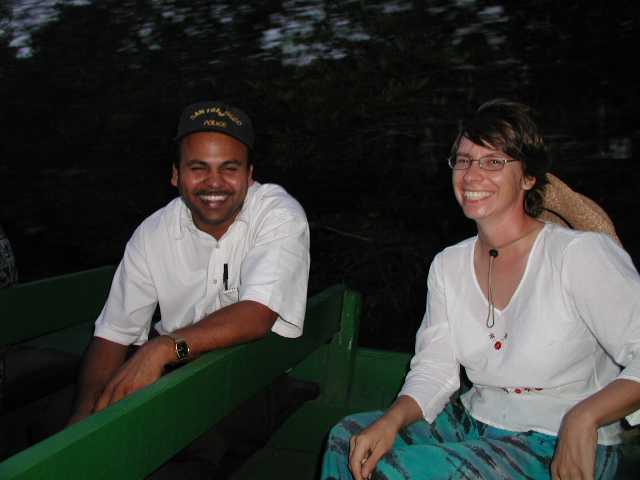
Christine with Jesse James at Caroni Swamp.
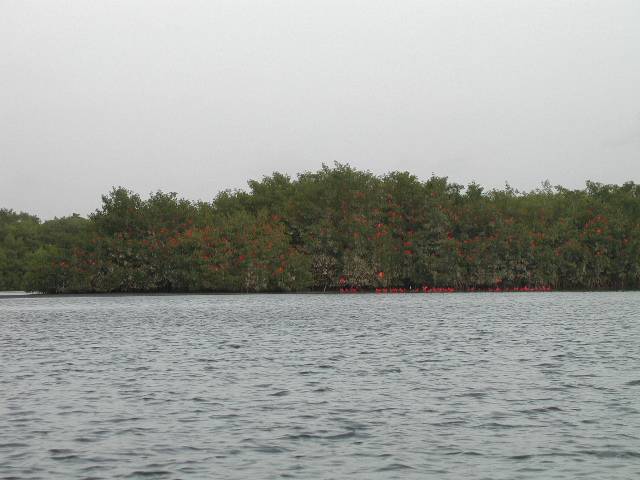
Roosting Ibis at Caroni Swamp
The following day we hauled out at Peake's boatyard, where the whole process was completed very quickly and professionally using a hydraulic tractor to transfer Anju from the travelift to her spot in the yard. We'd selected our spot carefully, taking into account the position to get maximum shade whilst we were working but hadn't noticed that the shady tree nearby was also laden with ripe mangos, which frequently woke us up during the night when they dropped from the tree and landed on the tin roof below, making an incredible amount of noise. The spot was wonderful for watching the bird and bat life though and during the night the security lights in the yard were so bright that you could actually sit and watch the bats at work keeping the mosquito population down. You could almost paint your boat too!
Our next task was to set to work on painting the topsides (the blue bit of the boat) before the rainy season started. We were lucky to get it finished quickly, as after about ten days in the yard, the dry weather ended and normal Trinidad weather returned. It seems that normal Trinidad weather is similar to normal Wales weather but of course much hotter.
To break up the hard work, we took an evening trip with Jesse to the north east coast of Trinidad, to Matura. The beach at Matura is a favourite place for the giant leatherback turtles to come ashore at this time of year, to lay their eggs. It took a couple of hours to drive there but sitting in the front of the maxi with Jesse, we had a guided tour of all the sights on the way.
After picking up our guide, we arrived at the beach, where we couldn't use any lights, otherwise the turtles would be disturbed and not come ashore. We had only just arrived when a turtle about five foot long began to come ashore right where we were, not an easy task for her in the big swell. We were very lucky as sometimes you have to walk a couple of miles up the beach to see them. We waited quietly while she made herself comfortable ready to dig her nest.
While we were waiting, our guide found a hatchling, which had been trapped in its nest and rescued it. Apparently the poor babies at the bottom of the nest rarely make it out alive without help, as the other babies use them to stand on. We had to take turns to babysit the hatchling, which was an exhausting responsibility as it didn't stop moving, trying to make its way to the sea. We were told it's good for the turtle to get some exercise after being trapped in the nest before taking to the sea, to improve its chances. After an exhausting half hour in charge, Christine worked out that the only way the baby would stop moving was if he was turned away from the sea!
The mother turtles first dig themselves a safe platform with their front flippers and then once settled, start digging with the back flippers, until they have a hole about two feet deep. Once they are happy with the hole, they start to lay, firstly small infertile eggs, to make a cushion for the real eggs and then around 70 or 80 fertilised eggs, finally followed up by some more infertile eggs, to protect those underneath. While laying the turtles are in a kind of trance, so you can take pictures and touch them. While we watched the first turtle, a dozen or so more began to come on the beach as well and start their trek up the beach to make their nests. It was magical! The guides measured the turtles, recorded the approximate number of eggs and their location, tagged them if they didn't already have a tag or recorded their tag numbers. The females each come ashore about every 10 - 12 days to lay a new batch of eggs.
Before we left we released the hatchling to take his chances in the sea, hoping that he would survive.
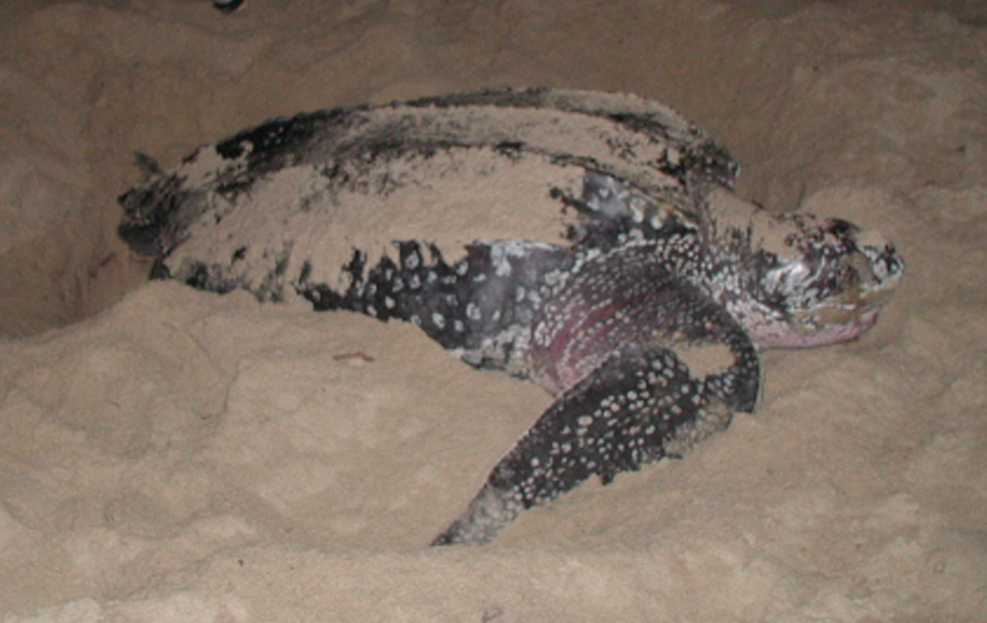
Female Leatherback turtle preparing her nest.
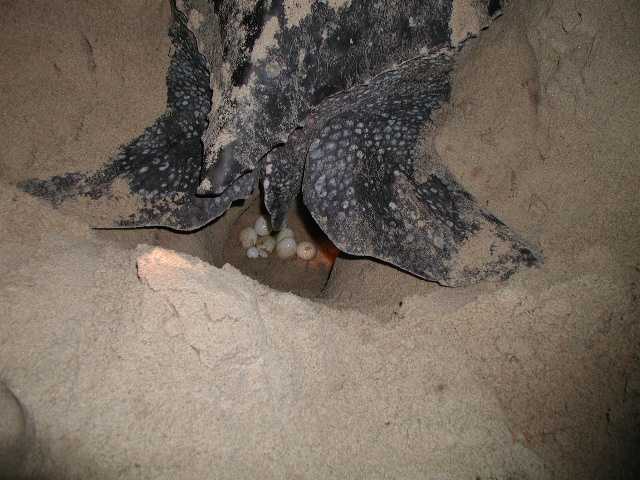
Starting to lay eggs.
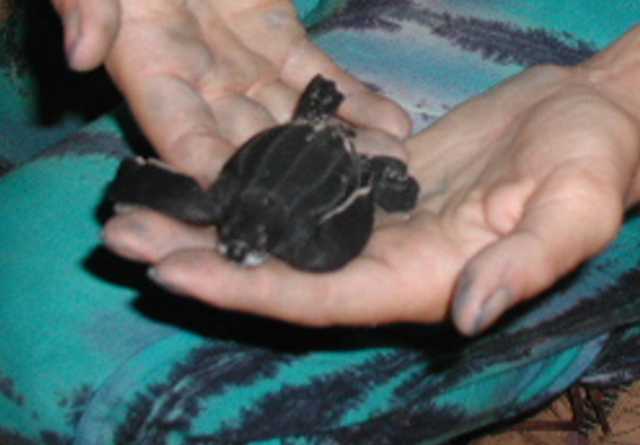
Christine exercising the rescued hatchling.
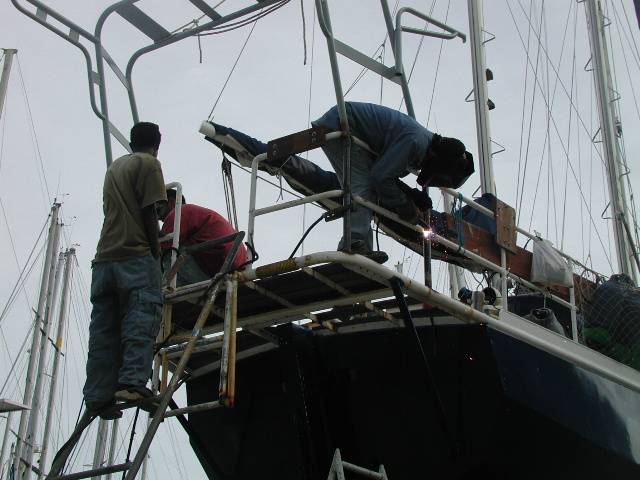
Ian, Chris and Lincoln from Chaguaramas Metal Works installing their creation.
Chris from Chaguaramas Metal Works set to work in steel pipe to make our ideas into something more solid and we were very pleased with his creation, which turned out much prettier than both we and he had expected. Of course once it was ready, it had to be lifted onto the back deck, now high above the yard, which although not an easy operation, was quickly accomplished with a team of four men, one woman and the mizzen halyard. It was then welded into our existing metalwork and on completion looked as though it had always been there. We are very pleased with it. Painting it was quite a scary and acrobatic feat!
By this time, after almost a month in the yard, we were in need of a break and were very happy when Jesse called to offer us an overnight trip to the Asa Wright Nature Reserve. A whole two days away from the boatyard, what a treat!
After a beautiful drive through the countryside, where Jesse pointed out everything of interest, we arrived at the Asa Wright Centre at about 11.00 and checked into our room. It used to be an old plantation house and still had that atmosphere. We just had time for a quick rest before our next meal. Jesse had warned us this trip would be an eating marathon and he was right. Lunch was a tasty buffet of fish in tomato sauce with salad and rice, followed by fruit salad.
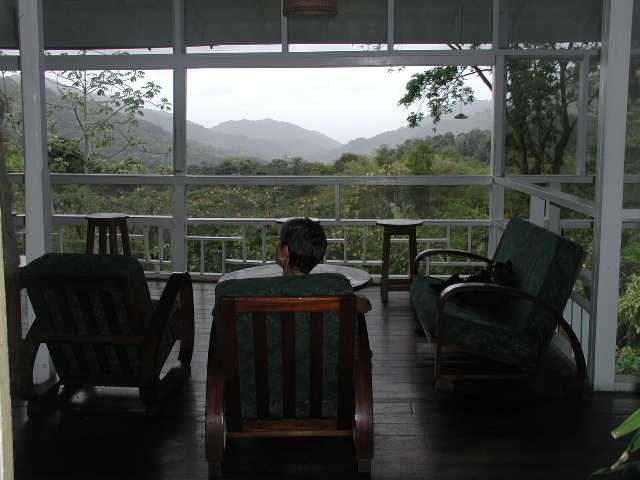
Christine enjoying the tranquility of the verandah at Asa Wright
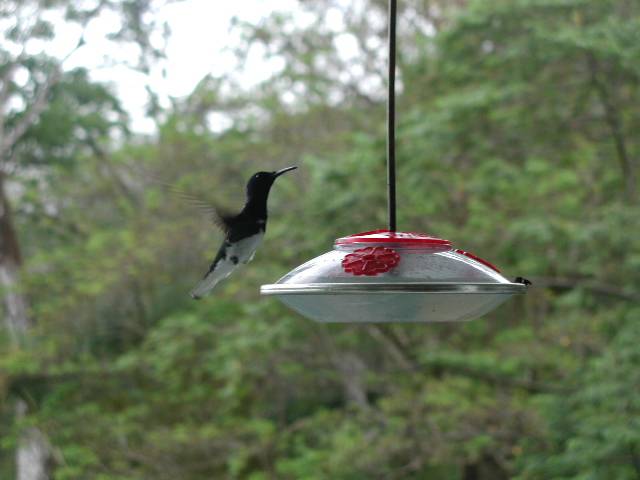
Hummingbirds at afternoon tea.
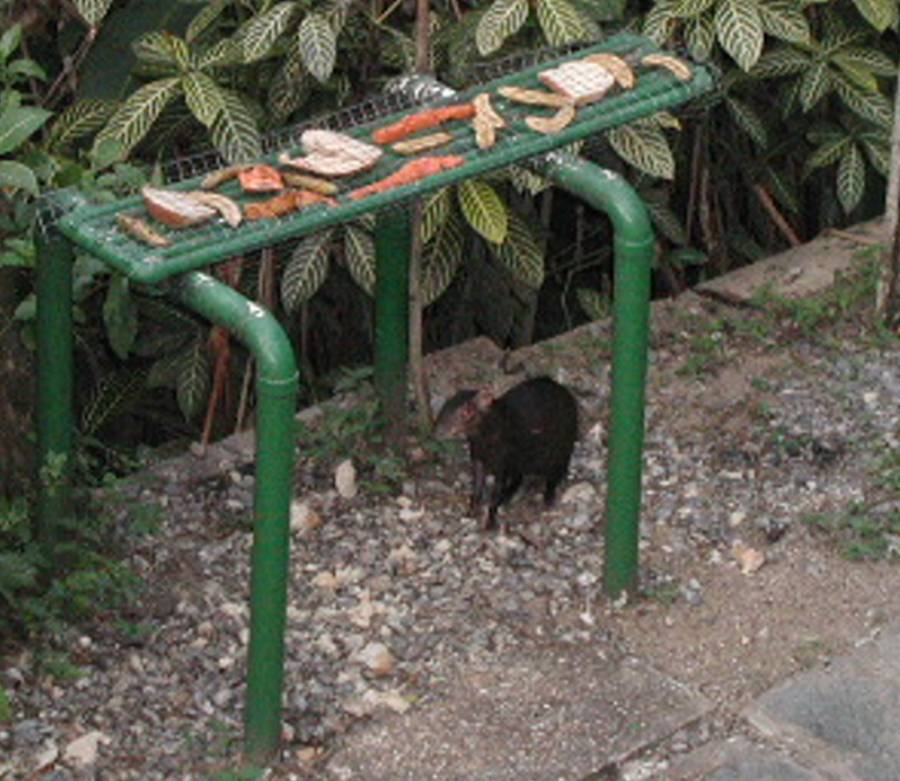
Agouti stealing the birds' breakfast!
After lunch we took a guided orientation walk with one of the guides, James. We didn't see too much bird life as the morning is apparently better, but we did see the manakins in their lek or territory, trying to attract mates. The black and white males flirt and make a cracking noise with their stiff wing feathers to attract the dull green girls. We also saw leaf cutter ant armies collecting bits of leaf to carry back to their nest. Apparently they grow fungus from the leaves inside the nest, and that is what they eat.
We were back on the verandah in time for afternoon tea and cakes and a front row seat to watch the many different types of hummingbird. After our tea we took a walk by ourselves on the Mot-Mot trial. Behind the plantation house we saw agoutis hiding in the undergrowth, they are like guinea pigs with long legs. We also visited the freshwater pool but didn't fancy a swim, the guppies looked too menacing. We only actually saw two.
Then it was time for cocktails on the verandah again. This time we were sitting with another guide, Mukesh, who convinced us that we should join him later on the night walk after dinner. Before dinner we saw lots of bats but unfortunately Christine forgot her bat detector.
Dinner was beautiful succulent stewed lamb with rice and salad. We'd already eaten so much that we didn't partake of the potato soup as well. Trifle for dessert and pleasant conversation with a honeymooning couple. He was a geneticist, working on checking the classification of bird species (wow). Anyway seems his honeymoon was a bit of a busman's holiday.
When we got back our nerves were a little frayed from worrying about all the invisible scary horrors, so we indulged in a beer with Theo and Marlene.
Next day we were up at 5.30 and on the verandah by 6.00 to see the early birds feeding. It was worth getting up for. As well as the hummingbirds, we saw the vividly coloured green honeycatchers. Not sure why they are called green, as they are vivid blue. The agoutis were also feeding and playing on the terrace below and we caught a few glimpses of the mot-mot bird, among many others. After breakfast it was time for another guided walk with Mukesh again. This time in the forest we managed to find the elusive bell birds, which make a noise similar an aboriginal musical instrument. They are certainly strange looking critters with their ugly wattles.
He then abandoned us in the heart of the forest as he had to rush back to take another tour. We took the trail back above the oil birds cave. He'd warned us not to be alarmed by their raucous cries and we were glad of the warning as they sounded like tigers fighting.
We made it back to our room just before a deluge luckily. All too soon it was time to pack our bags and Jesse picked us up at around 11.30. He drove us back a different route, following a winding country lane up towards the north coast. Unfortunately it was foggy, so we couldn't catch all the spectacular views but it was very interesting and we passed a car with about 10 members of a family inside, who were hunting land crabs for dinner.
After a stop to buy fruit of a type we'd never seen before, Jesse flagged down an electricity company van, who gave us a bag of mangoes gathered using the company ladders. He must still have thought we were hungry, so he stopped an ice cream van. We arrived at the beach in Maracas at about 1.30pm for lunch. It was time to get in our retaliation first and try a taste of shark, just in case. The famous Trinidad delicacy of "shark and bake" was our lunch, which turned out to be a shark burger in a doughnut-like bun. After a quick walk on the beach we headed back to Chaguaramas, which was still about an hour away. We decided against dinner that evening when we got home!
While we finished off the painting, Carlos from Alpha Canvas set to work on a sun and rain awning for us. It was quite a complex piece of canvas work, with all the rigging wires on our boat and two masts. Rain-catchers also had to be incorporated in the design. We waited a while but when it arrived it was wonderful and will make a big difference to life on board as we'll be able to make much more use of the deck with the shade it provides.
To improve safety on board we had new jackstays made. Jackstays are the safety lines to which you clip your harness when you go on deck in rough weather, so it was money well spent.
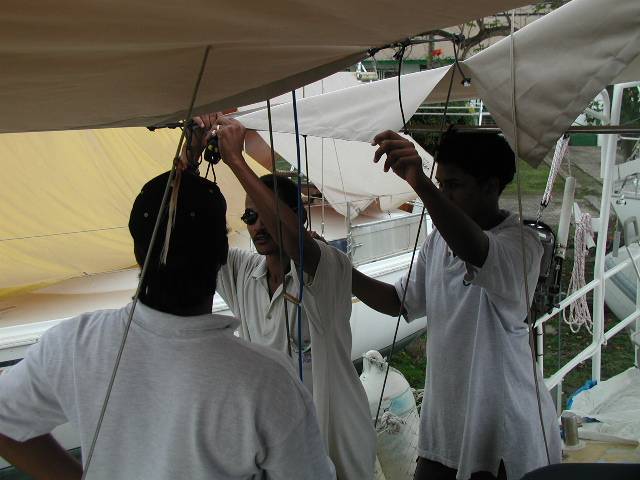
Carlos and the boys from Alpha Canvas working on the awning.
Trinidad has a large community of cruising yachts and has a daily VHF radio net for announcement of social events and so on. We heard one day on the net of a "Mount Gay Rum Promotion Night" at the Wheelhouse bar and decided it was time for us to learn how to socialise again, we were out of practice. So along we went at 5 pm. Phil bought one Mount Gay and was given a ticket for the raffle. Christine not liking the stuff drank something else. We caught up with old friends Nancy and Don from Texas Reb and Joan and Danny from Mainly before it was time for the raffle. Guess who won? The guy who had only bought one Mount Gay all night carried off a stack of prizes, a t-shirt, a towel and a large flag. However there was a catch, to receive your prizes you had to perform a song. As Phil got up to perform, for some reason the microphone stopped working, so the audience were treated to a silent and very funny rendition of the Lumberjack Song from Monty Python! We were home by 7 pm after our wild night out!
With all the work that was going on, the guppies and swordtails were a little neglected in Trinidad. It didn't seem to bother them at all and in fact we had four new arrivals, who we managed to rescue from the greedy jaws of their close family and who are now thriving in the nursery tank (formerly a dried mushroom container). It was lucky we spotted them at all. They are born live, unlike many fish, and on arrival consist mostly of a pair of eyes. Christine just happened to notice the four tiny pairs of eyes staring up at her as she passed to collect more paint, just in the nick of time!
The launch was booked for 2 pm and the launch team arrived for us at 1.30 pm. This was probably the only event that ever happened early in Trinidad (except maybe arrival of the rainy season). At least we didn't have time for any last minute worrying. Once Michael, the guy in charge of the hydraulic tractor, had delivered Anju safely to the travelift, Phil dabbed antifouling on the last spots where Anju had stood on the wooden blocks. Curiously Michael has spent a lot of time in Abergavenny in Wales with his Auntie who lives there - small world.
We were put back aboard for the launch so we could check our new stuffing box for leaks as soon as she was in the water (lucky - it did and Phil had to tighten it up quickly!). It was quite exciting riding on the travelift!
After our launch we headed to the anchorage to TTSA, a local yacht club, where we could carry on with our work and get Anju shipshape again.
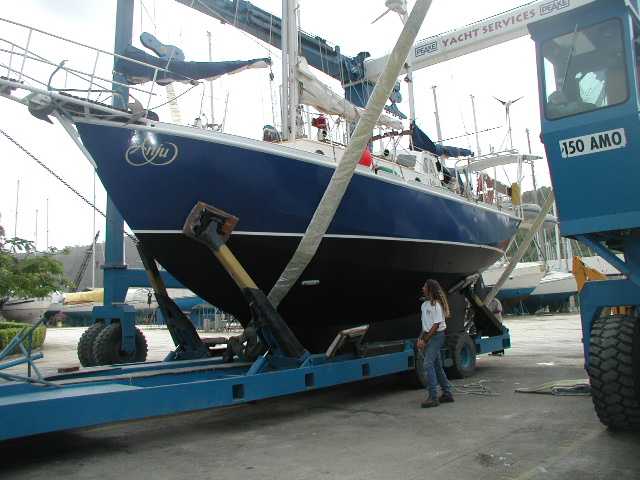
Michael putting shiny Anju in the travelift.
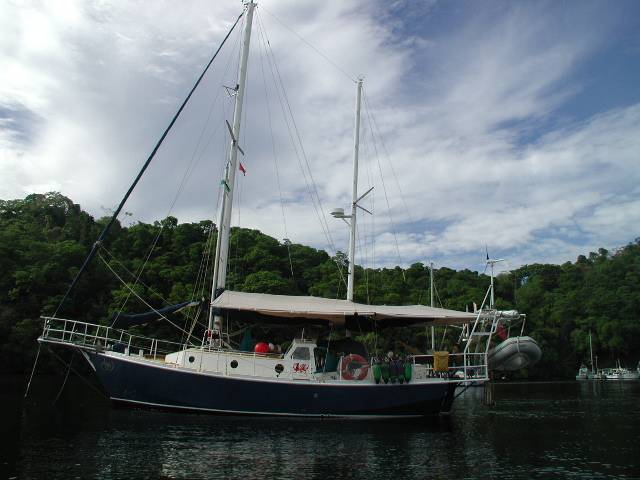
Anju showing off her new arch, dinghy davits, awning and paint job in the anchorage.